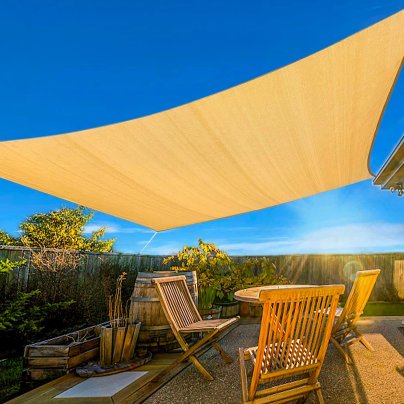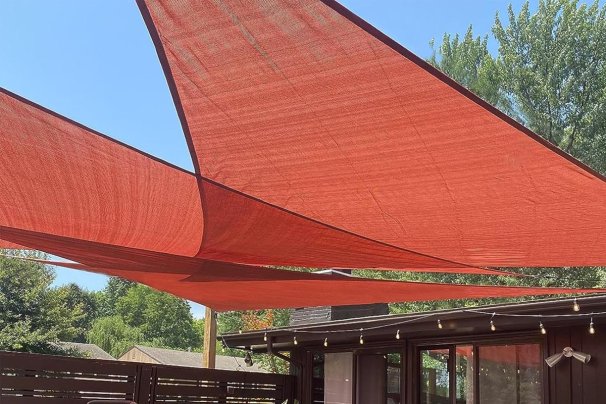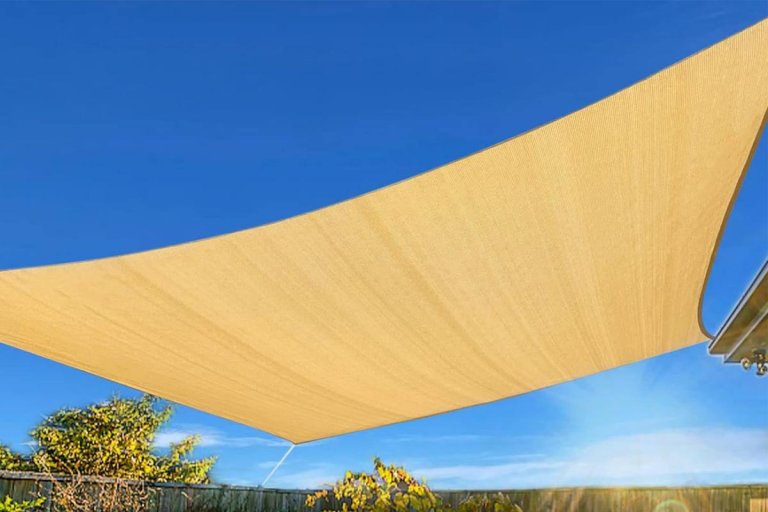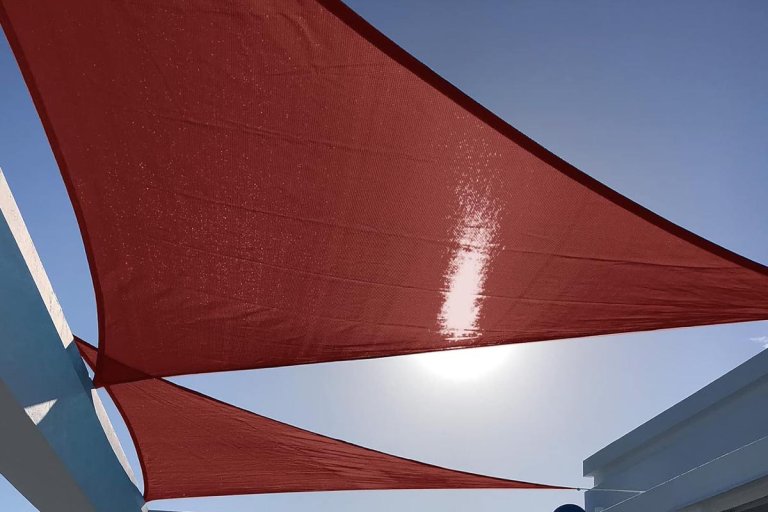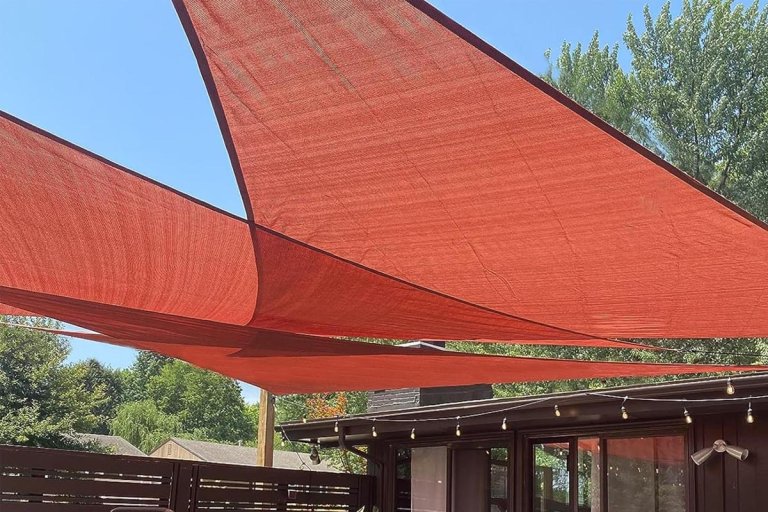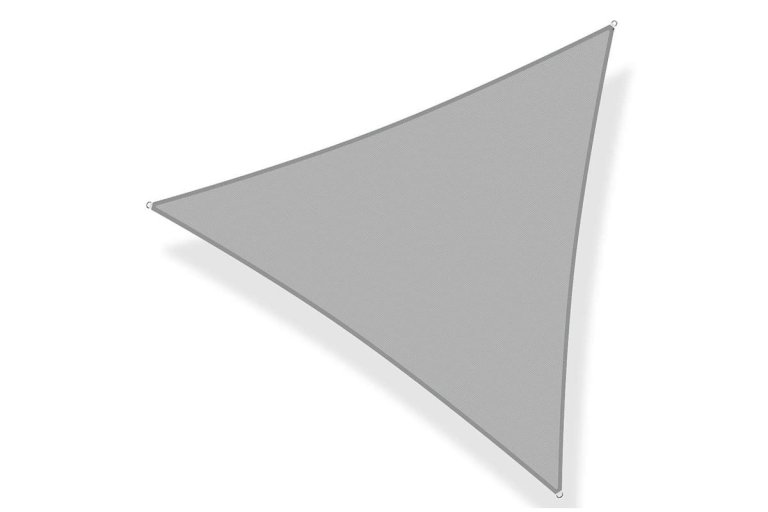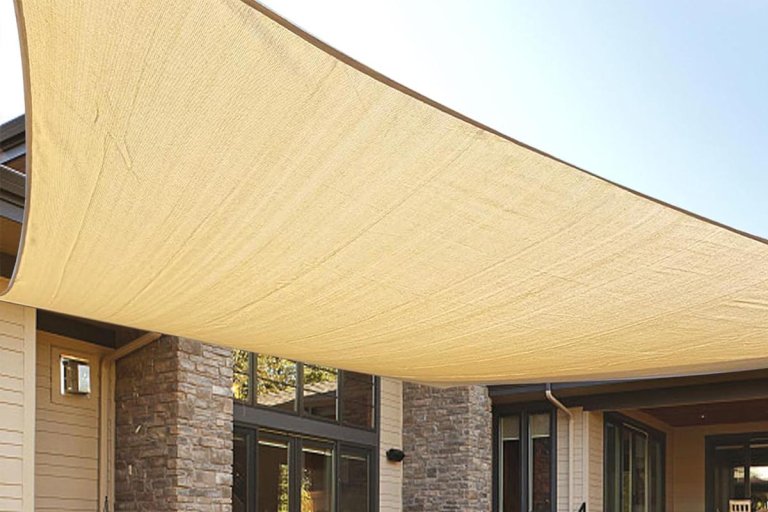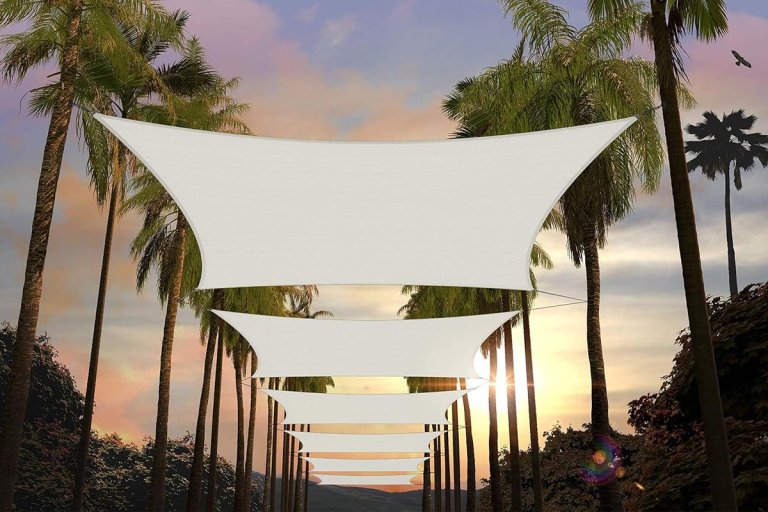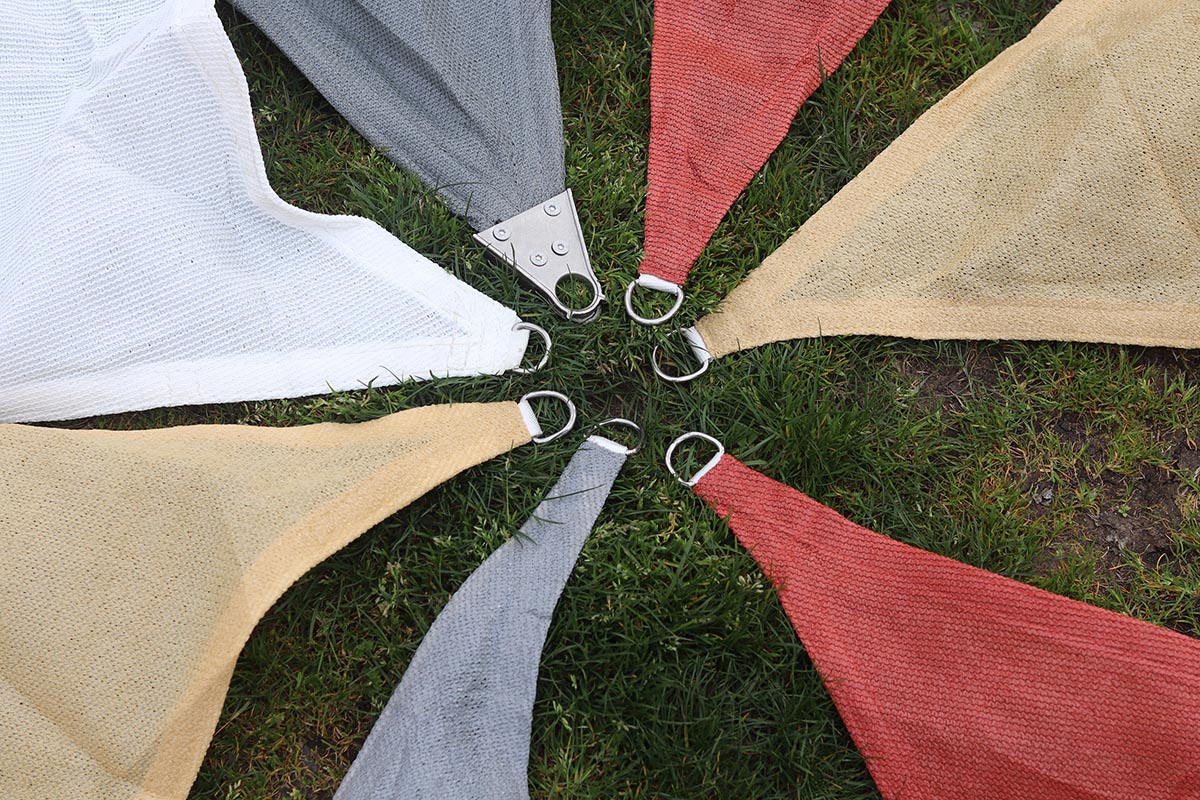
We may earn revenue from the products available on this page and participate in affiliate programs. Learn More ›
A shade sail is similar to a boat’s sail, except it’s attached to a roof or an outdoor structure to form a canopy. Tilted or twisted overhead, backyard shade sails offer protection from the sun on hot summer days. We researched dozens of shade sails and tested seven models for durability, ease of use, and performance. While these shady additions can be a beast to hang, they allow users to harness the beauty of a sail cloth shade at home and enjoy the outdoors in protective comfort.
Constructed from ultraviolet (UV)-resistant high-density polyethylene fabric, these flexible membranes come in a range of colors, styles, and sizes. Read on for tips on choosing the best shade sails for outdoor spaces and to learn more about the models that passed our testing.
- BEST OVERALL: Artpuch Rectangle Shade Sail
- BEST BANG FOR THE BUCK: Sunny Guard Triangle Sun Shade Sail
- BEST TRIANGLE SAIL: Love Story Permeable Triangle Shade Sail
- BEST FOR SMALL SPACES: Shade&Beyond Triangle Sun Shade Sail
- MOST VERSATILE: Love Story Permeable Rectangle Sun Shade Sail
- BEST CUSTOM SIZES: Amgo Rectangle Sun Shade Sail
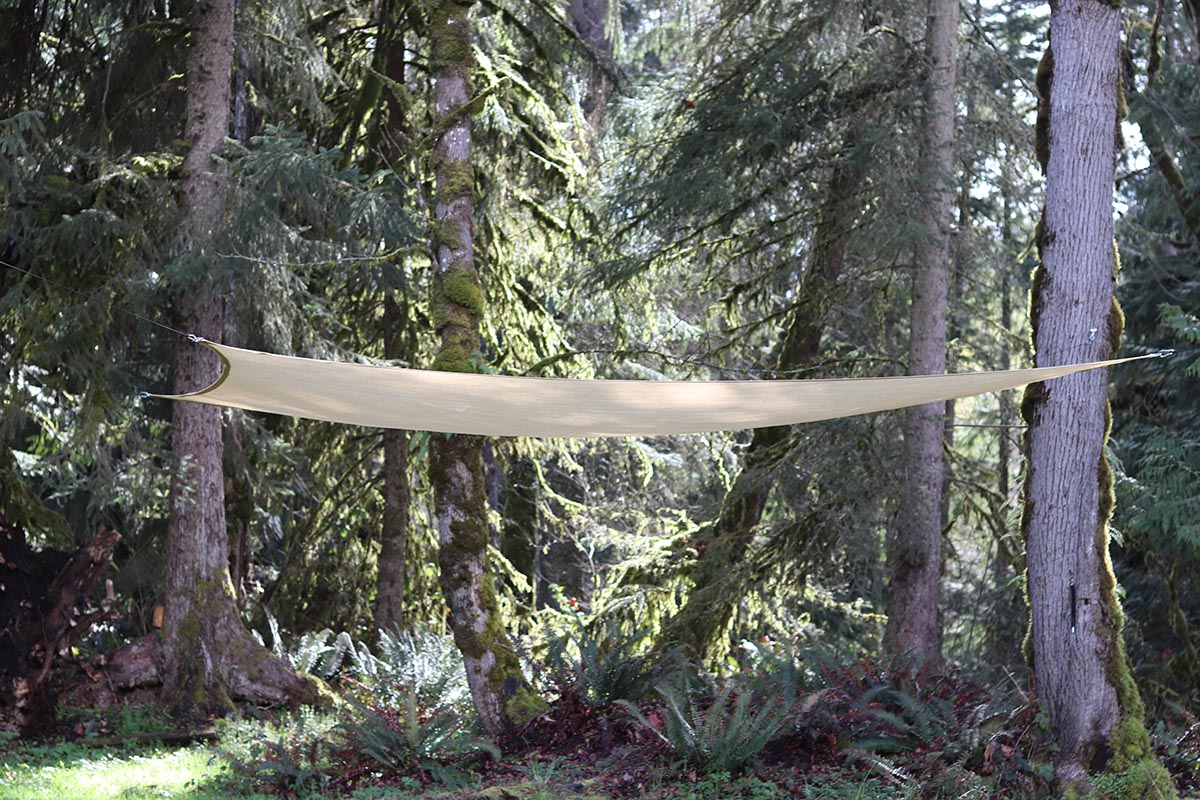
How We Tested the Best Shade Sails
None of the tested shade sails included hardware, so we installed our own shade sail hardware kit on four trees. We eventually added extra pulleys to the system to make installation easier. Each shade sail was hung and left open to the elements for 2 to 4 days, with all models being exposed to sun, rain, and wind. Debris from the trees fell on the shade sails, testing their durability. We rated products according to an established rubric, which covered the quality of the material, shade provided, and ease of installation. We paid particular attention to the corners and seams on the shade sails, as these are the points of greatest tension.
Testing Stats
- Products tested: 7
- Hours spent testing: 552 hours
- Tests performed: 3
- Price range: $29 to $48
Our Top Picks
Whether you have a postage-stamp garden or a sprawling lawn, these hand-picked recommendations for shade sails cover outdoor areas of most shapes and sizes. The selection criteria for the best shade sails focused on high-quality material, UV protection (more than 90 percent blockage), versatile features (color, size, and shape), sag-proof design, and longevity (5-plus years of use). After testing, these are the models that delivered on their promises.
Best Overall
Artpuch Rectangle Shade Sail
Pros
- 185 grams per square meter (GSM) construction with reinforced seams for long-term use and durability
- Performed well in wind and rain with no sagging, tearing, or pooling
- Blocks 95 percent of harmful UV rays; perfect for homes with children
- Sturdy stainless steel D-rings included for every corner that held up well to tightening and retightening
Cons
- No hardware or ties included for installation
Product Specs
- Materials: High-density polyethylene (HDPE) fabric
- Available sizes: 103
- Shape: Rectangular
Our Ratings: Installation 4/5; Appearance 4.5/5; Sun Protection 5/5; Durability 4.5/5; Value 4.5/5
Measuring 13 feet long by 10 feet wide, this 185 GSM rectangle shade sail from Artpuch has the materials, design, and specifications to meet nearly any outdoor space’s shade needs. It’s made of HDPE fabric with thickly stitched seams for added strength. The fabric blocks up to 95 percent of UV rays during sunny weather, offering summertime protection and cooling shade.
Each corner has a durable stainless steel D-ring, making this shade sail safe and easy to hang and position as needed without sagging or stretching. When measuring a space, allow for an additional 1.5 to 2 feet of space for the hardware and ropes (sold separately).
We tested this model over a 3-day period that, unfortunately (or maybe fortunately), was full of wind and rain with a single day of sun. However, we got a good look at how the Artpuch can withstand poor weather. It handled the wind and successfully let enough water through, preventing pooling. Plus, the curved edges helped water effectively run off. Debris of sticks, twigs, and leaves fell on it without causing damage. Like other rectangular shade sails we tested, this one took some adjusting to hang correctly. When installing the anchor points, make sure to read through the directions so that you situate the anchor points at the correct angle and distance.
Get the Artpuch shade sail at Amazon or The Home Depot.
Best Bang for the Buck
Sunny Guard Triangle Sun Shade Sail
Pros
- Protects against 95 percent of UV rays for cooling and sun protection in the yard
- Double-edged stitching at the seams adds durability to withstand inclement weather
- Good-quality fabric with a sleek look that makes the shade sail appear pricier than it is
Cons
- Not suitable for use in the winter; must be taken down when the temperature drops
- Doesn’t come with a hardware kit, and the included nylon ropes aren’t very useful
Product Specs
- Materials: HDPE fabric
- Available sizes: 136
- Shape: Triangular
Our Ratings: Installation 5/5; Appearance 5/5; Sun Protection 4.5/5; Durability 4/5; Value 5/5
This shade sail’s triangular shape can transform a small backyard into a home oasis. With UV protection of up to 95 percent, this shade sail can keep you cool and block harmful rays so that your outdoor space remains usable in the heat of summer. It’s made of strong high-density polyethylene that can withstand occasional wind and rain, but it should be taken down for prolonged inclement weather.
During testing, this model’s strong D-rings and reinforced seams withstood light winds and rainstorms when it wasn’t providing shade from the sun. The triangle shape made this model easier to hang. We anchored two points and tightened the sail with the remaining corner.
The triangular shape is highly versatile as it enables users to purchase multiple shade sails to cover various areas around an outdoor space. With the right hardware kit (sold separately), this sail should last for at least 5 years. The sail comes with nylon ropes and is designed to be hung at a 20- to 40-degree angle to allow water and dew to run off. The ropes aren’t very long, so the mounting pole would need to be very precisely placed. We found it easier to hang the shade sail with a slightly longer rope, giving us more room to adjust the tension. Installation was quick, though triangular sails don’t offer as much sun protection as other shapes.
Get the Sunny Guard shade sail at Amazon or Walmart.
Best Triangle Sail
Love Story Permeable Triangle Shade Sail
Pros
- 185 GSM material provides long-term durability; capable of withstanding occasional bad weather
- Permeable design helps to avoid pooling and damage due to inclement weather
- Blocks 95 percent of harmful UV rays; especially suitable for homes with children
- Offered in many sizes and shapes, though triangle sails are easier to hang
Cons
- Installation can be tricky for some buyers
- Hardware is sold separately, and the included nylon ropes are on the short side, making them less effective
Product Specs
- Materials: HDPE fabric
- Available sizes: 121
- Shape: Triangular
Our Ratings: Installation 5/5; Appearance 4/5; Sun Protection 4/5; Durability 4/5; Value 5/5
Measuring 16.5 feet on each of its three sides, Love Story’s triangle shade sail offers versatility without sacrificing style. Made of 185 GSM HDPE material, this sail’s breathable fabric allows both breezes and light rain to pass through. It held up to a rainstorm and moderate winds, even though the manufacturer recommends taking it down in inclement weather. It isn’t waterproof, but that lets water seep through and prevents pooling. It did a good job of blocking UV rays, offering a cool but protected outdoor space.
Curved edges further enhance the strength and prevent drooping. However, we also found that this reduced the shaded area by 4 to 6 inches per side. We also noticed that the triangular shade created a limited shaded area compared to the rectangular shade sails we tested. But the triangle shape made this shade easy to hang. All we had to do was attach two sides, tighten them, and then attach and adjust the third side.
This model came with nylon ropes to hang it, but they were too short for our setup. All other supplies, including hardware, are sold separately. We appreciated the wide range of sizing options, which includes custom shade sail sizes. Shoppers can also choose between a variety of colors and patterns.
Get the Love Story triangle shade sail at Amazon.
Best for Small Spaces
Shade&Beyond Triangle Sun Shade Sail
Pros
- 185 GSM construction is durable enough to withstand long-term use
- D-rings built into each corner help the sail withstand inclement weather and strong winds
- Breathable design flows with the wind; no need to worry about strong winds pulling on the posts
Cons
- Hanging kit is not included with purchase; may not be ideal for some users
- Fabric showed some flaws
Product Specs
- Materials: HDPE fabric
- Available sizes: 7
- Shape: Triangular
Our Ratings: Installation 5/5; Appearance 3/5; Sun Protection 4/5; Durability 4/5; Value 3/5
The triangular shape of the Shade&Beyond’s shade sail works extremely well for small spaces because it only requires three anchor points. When bought in a small size, it can offer extra coverage without requiring too much extra hardware to secure it. Triangle sails don’t cover as much area as rectangular alternatives, but they’re easier to hang, especially when your available space is limited. We tested the 12-foot-square model, which falls in the middle of this model’s seven size options. It also comes in 10 colors.
Constructed of 185 GSM UV-protected HDPE fabric, this shade sail features stitched seams and stainless steel D-rings at each corner. However, it doesn’t come with a hanging kit, so you’ll need to purchase one of those separately.
It survived a few breezy evenings and more than one rainstorm. Thanks to its permeable design, water doesn’t pool on its surface, and light breezes can pass through. As with most of the triangular models we tested, we found this one easy to hang.
Get the Shade&Beyond shade sail at The Home Depot or Walmart.
Most Versatile
Love Story Permeable Rectangle Sun Shade Sail
Pros
- Comes in 191 sizes to fit yards and patios of most sizes; 14 color choices
- 95 percent UV protection to keep you cool and protect from damaging rays
- Stainless steel D-rings on every corner can withstand strong winds and inclement weather
Cons
- Hanging hardware sold separately; may not be ideal for some users
- Shape makes it difficult to hang
Product Specs
- Materials: HDPE fabric
- Available sizes: 191
- Shape: Rectangular
Our Ratings: Installation 4/5; Appearance 5/5; Sun Protection 4/5; Durability 4.5/5; Value 4.5/5
Whether you need a shade sail that blends perfectly into your home’s facade or are interested in finding a colorful way to add a bit of shade to cover patio furniture, Love Story offers a wide range of options that might be suitable. It’s available in a whopping 191 different sizes that range from 6-foot-long by 6-foot-wide custom sizes to 24-foot-long by 20-foot-wide sizes to cover large areas. We tested the 16-foot-long by 12-foot-wide model.
The brand’s rectangle awning comes in 14 different colors and patterns. Similar to a few of the other top picks on this list, this shade sail is made of a high-quality 185 GSM HDPE fabric, has stainless steel D-rings at each corner, and sports a slight curve to prevent drooping. The curved design definitely helped it stay taught, even during light rain and winds.
The Love Story sail includes short nylon ropes for installation, but all hardware is sold separately. If you use the included ropes, you’ll need to be precise with mount locations. We found it easier to suspend this shade sail when we had more length from the mounting points.
Get the Love Story rectangular shade sail at Amazon or Wayfair.
Best Custom Sizes
Amgo Rectangle Sun Shade Sail
Pros
- Protects against 95 percent of UV rays; perfect for homes with children
- Heavy-duty webbing in the seamed edges provides long-term durability against inclement weather
- Comes in multiple sizes, including custom sizes, to accommodate small and large spaces alike
Cons
- Hanging hardware not included; needs to be purchased separately
Product Specs
- Materials: HDPE fabric
- Available sizes: 205
- Shape: Rectangular
Our Ratings: Installation 4/5; Appearance 5/5; Sun Protection 4.5/5; Durability 4.5/5; Value 4.5/5
Fit is essential when it comes to shade sails, so if you’re not willing to leave fit to chance, you’ll appreciate custom shade sails like the ones offered by Amgo. This brand offers 205 sizes, most of which are custom options to get the perfect fit. The Amgo sail also boasts 10 color options, all of which block UV rays by up to 95 percent.
This sun shade sail is measured from D-ring to D-ring, and the actual sail should be 6 inches to 1 foot shorter than the distance between mounting points. Our setup allowed us to adjust the positioning as needed, which is easy to do if you’ve got the anchor points lined up correctly. However, we found it easier to hang when we had some distance from the anchor point. It gave us some leeway in getting it taut.
While hardware does not come with this sail, it does feature durable, breathable HDPE fabric. Amgo finishes the sail with heavy-duty webbing inside the seamed edges to prevent fraying and help keep the sail tight. It survived 2 days of rain and wind without trouble, though we had to tighten the ropes after the storms, which had more to do with our ropes than it did the shade sail. Enough water got through the permeable fabric to prevent pooling.
Get the Amgo shade sail at Amazon or The Home Depot.
ALSO TESTED
ColourTree Rectangle Super Ring Sun Shade Sail
We also tested the ColourTree rectangle shade sail. At first glance, this shade sail seemed like a heavy-duty option that could endure hard weather without a problem. It has metal plates secured with four screws. A thick wire runs through each corner and along the edges to further reinforce the seams.
We kept it installed for 3 days. When we took it down, we discovered that the screws at two of the corners had torn through the fabric. This shade sail was up during a relatively calm weather period, during which there was only light wind and a few sprinkles. Consequently, we were surprised that it was so damaged after such a short time. We tested the 24-foot-long by 20-foot-wide model, and the fabric is 260 GSM, so it’s possible that the size and weight played a factor in the damage. It’s possible that smaller sizes of this model might be less likely to tear, but we can’t recommend it knowing that 3 days of light use left it compromised.
Jump to Our Top Picks
What to Consider When Choosing a Shade Sail
If you’re looking for a way to add shade to an outdoor space, a shade sail may be the best solution. These beautiful backyard canopies block out harmful UV rays while adding elegance to an outdoor area. Here are a few things to consider when shopping for shade sails for patios, decks, and other outdoor recreational spaces.
Shape and Material
Most outdoor sail shades are made of tightly woven high-density polyethylene fabric, polyvinyl chloride (PVC), or nylon fabric. These materials are often used to construct patio furniture and other items that stay outdoors 24/7. Shade sails are installed by stretching the fabric and using tension to attach the corners of the shade to a stable structure (such as a roof, post, wall, or tree) via stainless steel D-rings and turnbuckles (stainless steel devices to adjust tension). If installed correctly, shade sails should provide a perfectly taut canopy.
Shade sails come in a variety of shapes and styles but are typically sold in three shapes: triangle, square, and rectangle. Of the three, the triangular sail is the most popular. This is because square sun shade sails have a tendency to bow in the middle due to a buildup of water. They’re also not as elegant, and they’re harder to install than triangular sails. Perfect for both small and large areas, triangular sails can be layered for a more dramatic effect.
Weather Resistance
All shade sails should offer maximum sun-blocking power. Look for fabrics with a UV protection factor (UPF) of 90 percent or higher. Sun shade sails are designed to protect the skin and eyes from the sun’s harmful rays. Beyond UV protection, shade sails are built to withstand varied weather conditions, especially rain and wind. If you live in an area with harsh winters or severe storms like hurricanes, you may want to stow your shade sail until spring.
The benefit of HDPE material is its stretchy breathability, as this allows wind and rain to pass by without damaging the shade itself. Although HDPE sails can withstand heat, wind, and rain, they’re not designed to protect users during a storm. If there’ll be a strong thunderstorm or hurricane coming through, you’ll want to take your shade sails down to prevent them from getting damaged.
PVC is less breathable, but it creates the perfect waterproof shade sail. This is helpful if you want to use your sail shade canopy during summer showers instead of a pop-up canopy. In this case, position the sail at a slant so it doesn’t collect water (leading to a heavy, sagging canopy).
Measurement and Installation
Before settling on a sun shade sail, be sure to measure the outdoor space correctly. Leave a perimeter (1.5 to 2 feet) around the shaded area for the turnbuckles, which will attach the sail to a roof or other elevated structure. Remember: Shade sails are measured from the edge of their D-rings, which are fitted to each corner for hanging purposes. In most cases, you’ll need to purchase a hardware kit intended for either a triangle or rectangle sail.
Make sure to attach the hardware to a structurally sound point, like a home’s roof. Both rectangle and triangle shade sails are often installed at a slant to prevent rainwater from pooling. However, many residential shade sails are made with HDPE material, which allows water to pass through.
Shade sails can also be installed flat or twisted into a hyperbolic paraboloid (also known as a hypar twist). This three-dimensional shape is achieved by attaching one or two corners higher than the other corners. The benefit of a twist is a greater distribution of surface tension and a stronger shade sail overall. The end result is also beautiful aesthetically.
For another bold architectural effect, try installing overlapping shade sails. This extends a shady area without putting too much tension on a single big sail. When installing overlapping sails, make sure to leave a minimum of 12 inches between them. If not, wind and weather conditions can cause the sails to rub against each other, damaging the fabric over time.
FAQs
These sleek canopies can be a beautiful addition to any home. But before you click “add to cart,” here are a few common questions and their answers.
Waterproof patio shade sails need to be angled so that the water can run off and not pool. In most cases, the best way to achieve this is by angling the posts 5 degrees away from the direction of the load. For square-shaped sails, keep two corners at a high height and two corners at a low height. For triangular options, keep one corner at a low height and two points at a high height.
It depends. Shade sails made of HDPE are typically breathable, allowing rain to pass through. Sails made of PVC or explicitly labeled as “waterproof” will keep the rain out (but should be installed at an angle to prevent rain from pooling in the canopy).
Installing a shade sail may take more than one set of hands, but it can be an easy task if done right:
-Choose a properly sized shade sail to cover the desired area.
-Measure the sail and then dig 3 to 4 holes for the corner posts. Ensure that the posts are installed on a 5-degree angle to prevent pooling.
-Insert the posts into the holes and fill any outstanding area in the hold with cement to keep the posts in place.
-Install the eye hooks or D-rings to the posts.
-Secure the shade to the eye hooks or D-rings. Enjoy!
The longevity of your deck shade sail will depend on local weather conditions and whether you leave it outdoors all year long. However, if properly cared for, a shade sail will typically stay in good condition for 5 to 10 years.
If you live in a moderate climate where wind and rain are infrequent, you can leave a shade sail up all year. However, even then, you’ll want to take it down if you expect a particularly bad storm. In areas with harsh winters, the shade sail should be taken down in the fall as the weather starts to turn.
A shade sail should be tight to prevent pooling water. However, installing it tightly relies on the location of the posts and anchor points. You’ll want to calculate them carefully according to the manufacturer’s instructions before installing poles or anchor hardware.
Meet the Tester
Stacey L. Nash has written about home and garden products, home design and decor, and general indoor and outdoor home improvement for 5+ years. She’s passionate about research and hands-on testing to find the products that add true value to homeownership and daily life. She lives on 12 heavily wooded acres, where she and her family put home and outdoor products to the test while avoiding bears and cougars.
Additional research provided by Andréana Lefton.
